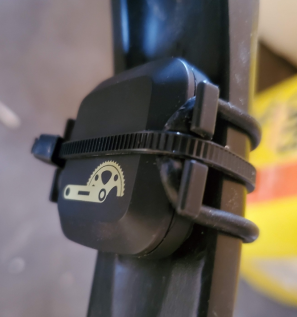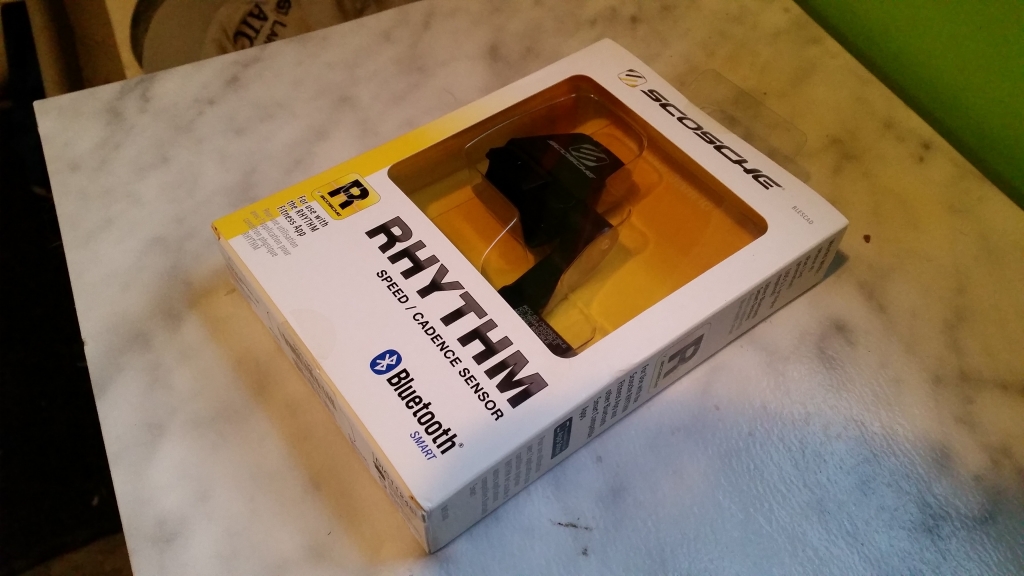Recently I decided to delve into gravel biking more seriously (there might be a future blog post about this, who knows). Yea, I know – maybe a bit late to the party and I’ve certainly ridden a good share of gravel with my endurance bikes and mountain bikes; just not with a dedicated gravel bike.
I needed a few things for the new bike, one of which was a cadence sensor. I could have bought another Wahoo (review here) or a cheapo one like the CooSpo (review here), either of which works just fine. But after a bit of thought, I decided to give a try to the Magene S3+ Cadence/Speed 2-in-1 Sensor.
When perusing and shopping around looking at bike sensors and such I have been seeing Magene and this cadence/speed sensor kicking around quite often.
Magene is a Chinese manufacturer of very low-cost biking equipment, established in 2015. Heck, they even sell a bike radar and a couple of power meters!
To put it simply – I decided to give this cadence/speed sensor a try for fun, considering it is about $17 (as of October 2023) and really I don’t see myself riding gravel as much as the road. I just need something that works halfway decent.
So I was pleasantly surprised to find how well this sensor works.
[one_half] [/one_half][one_half_last]
[/one_half][one_half_last] [/one_half_last]
[/one_half_last]
The package is a simple box but does not look cheap, with a few specs shown and a photo of the sensor on the outside and also a list of what’s included in an illustration on the back. Nothing here that screams super-cheap.
The contents of the box are standard stuff – the sensor is in a sealed anti-static zip-lock plastic bag, instructions (written plainly and just fine), a common warning thingy, a biz card for their virtual training software (more about this later), the rubber backing and two rubber bands in different sizes in another bag.
It says IP66 on the package but on Amazon at the top it says IP65, later in the Amazon page stats it does show the IP66 so I assume it was an oversight at the top info and possibly a hold-over from the older model of this sensor on Amazon. The difference would be how water-resistant it is. It’s a fairly small difference but since the package itself as well later stats on the Amazon page does say IP66 I assume that is correct.
IP66 means it is dustproof and very water resistant – I say water resistant instead of waterproof because I don’t think that you want to leave it underwater, though who in what situation would be doing that? For riding through the rain, big puddles, and mud this rating is going to cover those conditions.
The total weight of the sensor itself is 9 grams with the battery and the sensor measures about 4.49 x 3.15 x 0.87 inches (8.85×29.8×38.3mm). It’s a fairly slim sensor, in case you have a very small clearance – but not the thinnest that you can get.
The CR2032 battery (included) is inside the sensor and protected from powering it up while in transit by a plastic shield that you need to remove. To remove it you just twist the little waterproof door to the side, there’s a pointer and embossed lock and unlock symbols on the back of the sensor to show you which way to turn it and lock and unlock it. Pretty easy to open yet the water-resistant seal seems good quality.
[one_half] [/one_half][one_half_last]
[/one_half][one_half_last] [/one_half_last]
[/one_half_last]
You just remove the plastic shield from the battery and discard it, then re-insert the battery and turn the battery cover back into the lock position. On the front is a little embedded LED that shows either red or green when the sensor is woken from sleep. You of course can only use the sensor for one or the other – speed or cadence, and not both at the same time.
Red means it is in cadence mode, green means it is in speed mode. To toggle it just take out the battery again and re-insert it, lock it back up and it will switch to the opposite sensing mode. Pretty easy and very similar to some other company’s models.
The battery is standard CR2032 like you find pretty much everywhere. The company claims 500 hours of life, but that seems like a lot. I am a bit skeptical about that battery life figure, and one reviewer on Amazon noticed that as soon as the sensor detects any movement it comes out of sleep. So the reviewer believes that the battery life would not be as long as advertised if they were, say, carrying the bike on the back of a car.
I checked this myself and it does NOT seem to come out of sleep at just any sort of movement when it detects motion. It only would come out of sleep for me when I actually started to rotate the crank arm. There’s no way to really check this easily (without mounting a camera to the bike facing the sensor while driving) but I am guessing that just carrying it on a car isn’t going to discharge the battery power.
This sensor is of course using an accelerometer, which is an electromechanical device and so no external magnet is needed on your crank.
This Magene Sensor attaches via the included rubber band things, standard stuff for sensor and other bike-related devices. There are two sizes included – only one is needed to attach it. Between the sensor and the crank arm is a rubber pad with a tab that fits into the sensor to keep it all steady and in place on your crank arm. I don’t mind the rubber bands I guess, but I added a zip tie around it as these rubber bands tend to eventually break or get pushed out of the way or unsnapped from the little tabs on the sensor that they go around.
Also, on the CooSpo cadence sensor that I previously reviewed – one of the tabs broke off after taking a knock while mountain biking and allowed the rubber band to slip, the zip tie I put on kept it all in place. So I really would urge you to zip-tie it or something in addition to the rubber band attachment, or use zip ties totally in place of them. Those rubber bands never seem to hold up under heavy hits and scrapes and over time deteriorate.
You can see in the pic here the crank has a bit of a concavity but not enough where the rubber pad under the sensor didn’t secure it well. This of course is before adding the zip tie (and please excuse the dust and dirt on my gravel bike!).
With the two sizes of rubber band mounts, it should fit pretty much any crank arm and probably even things like stationary bikes, I believe.
The only slight issue you might have is a crank arm with a very very concave inner section to the arm. In which case you just need to put a little shim in the concave section to take up that little space a bit for a more secure sensor position. I have had to do this with a few sensors on other bikes, not a big deal.
The sensor is fairly thin though not the most thin of these types, so even if your crank arm is fairly close it should clear. If you have very little space there you might just want to check measurements before buying though.
The speed option seemed to work fine from a casual quick test of it, but I didn’t test it for accuracy or past the point of just seeing that my Edge detected it and connected to it in speed mode, and displayed a speed while I moved the wheel. It attaches on either the front or rear hub of course, instead of on the crank.
The sensor has the standard Bluetooth 4.0+ and ANT+ for connecting to devices. It of course works with pretty much anything and everything that has Bluetooth or ANT+; bike computers, phone apps, trainers and computers connected to them, etc. It can be connected to multiple devices, though only one Bluetooth I believe.
 Connecting to my Garmin Edge 520 Plus was quick and easy and standard as any sensor. The same with a quick test I did in a few apps on my phone.
Connecting to my Garmin Edge 520 Plus was quick and easy and standard as any sensor. The same with a quick test I did in a few apps on my phone.
Of note here, like most devices and sensors of this type to connect it to a phone you have to sync it in whatever app you are using, not via the phone’s Bluetooth pairing.
For the cadence sensor I doubt that most apps or computers or watches or what have you need a wheel size manually set as it is done automatically, and perhaps so for the speed sensor. Though most things in my experience do have the ability to manually set your wheel size if using the sensor in speed mode, and I don’t believe that this is ever necessary with a sensor in cadence mode.
Magene also makes an app for support of the sensor, for Android and Apple. In cadence mode it shows battery power and basic info like the actual cadence, and it is used to update the firmware. It also has some help and support and it is usable and works fine, though a few minor prompts were in Chinese yet it was easy to figure out that they just were basic continue prompts, etc so no big deal there. Don’t expect it to record any data as it is just a utility.
I didn’t check for how well it worked in the app for speed mode but I assume it works the same and as well.
The Magene Cadence/Speed Sensor goes into power-down mode after about a minute and comes right back up quickly, pushing data as soon as it wakes. Very typical of these types of sensors – some have a longer time period before sleep, and some have varying times before they start delivering data after coming out of sleep, usually very short time periods.
Surprisingly I think – and this is totally my own observation and not backed by any data as I didn’t time such short intervals – but I think the latency on this is as good or better than some brand name ones that I have. Again, this is totally unscientific and perhaps I should have taken some time to actually test this but it does seem to start pushing cadence data as quickly as any other sensors I have after, say, coasting down a long hill (where it shows zero cadence) and then coming up to full cadence in a fairly short time when I did start pedaling again.
Data rate itself is okay, maybe not the greatest but it does its job just fine.
A casual comparison with another sensor with both running seemed to show comparable and favorable data rates. Magene mentions that this is the second generation of this sensor, and is more accurate and such so it might be worth it to make sure you are getting the newest version if you order it somewhere besides my Amazon link.
I probably should have included the cadence graph from the sensor I was testing it in parallel with but I was recording that another another device and didn’t save it, oops. It is very very similar to this gravel ride (my normal road biking cadence is much more even and sustained than this, but it doesn’t seem to be so much gravel biking on hard roads).

On a side note – Magene has its own VR indoor bike trainer app called Onelap. I gave it a try and while the graphics aren’t as good as Zwift, it worked fine, though it didn’t have my specific smart trainer as an option. And it is free. To log into it use the same login info you used when installing the Magene app.
So – back to the sensor; so far so good, especially on rough and dirty roads. I’ve taken a number of rides, some pretty touch and others very muddy, and in the cool temperatures. No issues, problems, or anything negative to report. The sensor works just fine.
For the incredibly low price and ease of installing and using it I readily give it a thumbs up so far. Time will tell on its longevity, especially under rough conditions and occasional splashes of dirty water and things like that.
I of course will update this page if there are any issues.
If you are in the market for a cheapo cadence or speed sensor then give the Magene S3+ Cadence/Speed 2-in-1 Sensor a try.













